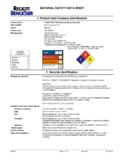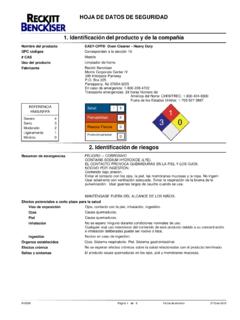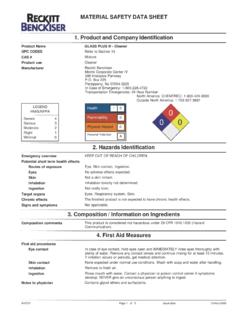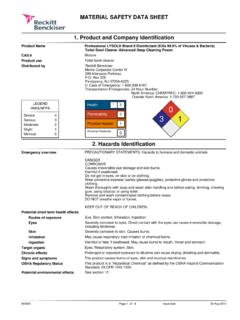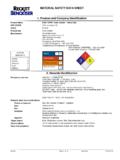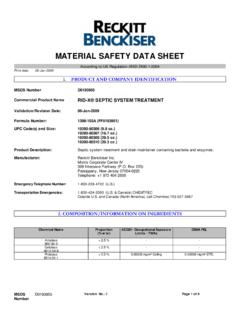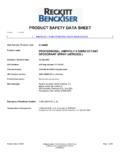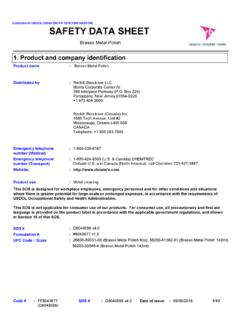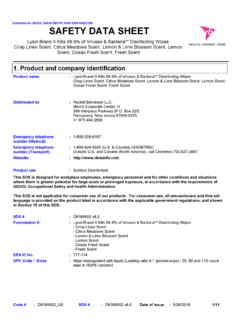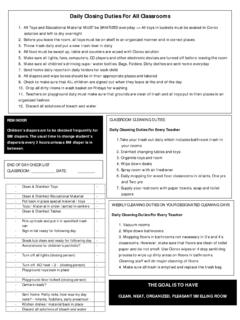Transcription of SAFETY DATA SHEET - rbnainfo.com
1 Air Wick 4 in 1 Air freshener - Fresh WatersAir care, instant action (aerosol sprays) SAFETY data SHEETP roduct nameDistributed byProduct use1. Product and company identification:::D0301281:SDS #Formulation #::#0299265_2 Air Wick 4 in 1 Air freshener - Fresh WatersRelevant identified uses of the substance or mixture and uses advised againstNot applicable.:Website: telephone number (Medical)Emergency telephone number (Transport):1-800-338-61671-800-424-9300 ( & Canada) CHEMTREC Outside and Canada (North America), call Chemtrec:703-527-3887:This SDS is designed for workplace employees, emergency personnel and for other conditions and situations where there is greater potential for large-scale or prolonged exposure, in accordance with the requirements of USDOL Occupational SAFETY and Health SDS is not applicable for consumer use of our products. For consumer use, all precautionary and first aid language is provided on the product label in accordance with the applicable government regulations, and shown in Section 15 of this to USDOL OSHA 29 CFR HAZCOMR eckitt Benckiser Corporate Center IV 399 Interpace Parkway ( Box 225)Parsippany, New Jersey 07054-0225 +1 973 404 2600 Reckitt Benckiser (Canada) Tech Avenue, Unit #2 Mississauga, Ontario L4W 5S9 CANADA Telephone: +1 905 283 70002.
2 Hazards identificationClassification of the substance or mixtureGASES UNDER PRESSURE - Compressed gas:Hazard pictograms:GHS label elements1/1215/12 of issue:SDS #FF0299265_2:Code #D0301281:D0301281 Conforms to USDOL OSHA 29 CFR HAZCOM2. Hazards identificationSignal word:WarningHazard statements:Contains gas under pressure; may explode if label elements:None not otherwise classified:None :Not :Not :Protect from sunlight. Store in a well-ventilated :Not applicable.:Read label before use. Keep out of reach of children. If medical advice is needed,have product container or label at statements3. Composition/information on ingredientsMixture:Substance/mixtureEthy l - 564-17-5disodium tetraborate - 11303-96-4 Ingredient nameCAS number%There are no additional ingredients present which, within the current knowledge of the supplier and in the concentrations applicable, are classified as hazardous to health or the environment and hence require reporting in this concentration shown as a range is to protect confidentiality or is due to batch First aid measuresWash out mouth with water.
3 Remove dentures if any. Remove victim to fresh air and keep at rest in a position comfortable for breathing. If material has been swallowed and the exposed person is conscious, give small quantities of water to drink. Stop if the exposed person feels sick as vomiting may be dangerous. Do not induce vomiting unless directed to do so by medical personnel. If vomiting occurs, the head should be kept low so that vomit does not enter the lungs. Get medical attention if adverse health effects persist or are severe. Never give anything by mouth to an unconscious unconscious, place in recovery position and get medical attention an open airway. Loosen tight clothing such as a collar, tie, belt or flush eyes with plenty of water, occasionally lifting the upper and lower eyelids. Check for and remove any contact lenses. Continue to rinse for at least 10 minutes.
4 Get medical attention if irritation contaminated skin with plenty of water. Remove contaminated clothing and shoes. Get medical attention if symptoms occur. Wash clothing before reuse. Clean shoes thoroughly before victim to fresh air and keep at rest in a position comfortable for breathing. If not breathing, if breathing is irregular or if respiratory arrest occurs, provide artificial respiration or oxygen by trained personnel. It may be dangerous to the person providing aid to give mouth-to-mouth resuscitation. Get medical attention if adverse health effects persist or are severe. If unconscious, place in recovery position and get medical attention immediately. Maintain an open airway. Loosen tight clothing such as a collar,tie, belt or contactSkin contactInhalationIngestion::::Descriptio n of necessary first aid measures2/1215/12 of issue:SDS #FF0299265_2:Code #D0301281:D0301281 Conforms to USDOL OSHA 29 CFR HAZCOM4.
5 First aid measuresProtection of first-aiders:No action shall be taken involving any personal risk or without suitable training. It may be dangerous to the person providing aid to give mouth-to-mouth to physician:Treat symptomatically. Contact poison treatment specialist immediately if large quantities have been ingested or treatments:No specific important symptoms/effects, acute and delayedInhalation:No known significant effects or critical known significant effects or critical hazards.:IngestionSkin contact:No known significant effects or critical known significant effects or critical hazards.:Eye contactOver-exposure signs/symptomsSkin contactIngestionInhalationAdverse symptoms may include the following:respiratory tract irritationcoughingNo specific specific data .:::Eye contact:Adverse symptoms may include the following:irritationrednessPotential acute health effectsSee toxicological information (Section 11)Indication of immediate medical attention and special treatment needed, if necessary5.
6 Fire-fighting measuresPromptly isolate the scene by removing all persons from the vicinity of the incident if there is a fire. No action shall be taken involving any personal risk or without suitable training. Move containers from fire area if this can be done without risk. Use water spray to keep fire-exposed containers thermal decomposition productsSpecific hazards arising from the chemicalDecomposition products may include the following materials:carbon dioxidecarbon monoxideIn a fire or if heated, a pressure increase will occur and the container may aerosol containers may be propelled from a fire at high should wear appropriate protective equipment and self-contained breathing apparatus (SCBA) with a full face-piece operated in positive pressure protective equipment for fire-fightersUse an extinguishing agent suitable for the surrounding media:::None extinguishing media:Unsuitable extinguishing media:Special protective actions for fire-fighters:3/1215/12 of issue:SDS #FF0299265_2:Code #D0301281:D0301281 Conforms to USDOL OSHA 29 CFR HAZCOM6.
7 Accidental release measuresEnvironmental precautionsPersonal precautions, protective equipment and emergency proceduresStop leak if without risk. Move containers from spill area. Approach release from upwind. Prevent entry into sewers, water courses, basements or confined areas. Wash spillages into an effluent treatment plant or proceed as follows. Contain and collect spillage with non-combustible, absorbent material sand, earth, vermiculite or diatomaceous earth and place in container for disposal according to local regulations (see Section 13). Dispose of via a licensed waste disposal contractor. Contaminated absorbent material may pose the same hazard as the spilled product. Note: see Section 1 for emergency contact information and Section 13 for waste disposal.::No action shall be taken involving any personal risk or without suitable surrounding areas.
8 Keep unnecessary and unprotected personnel from entering. In the case of aerosols being ruptured, care should be taken due to the rapid escape of the pressurized contents and propellant. If a large number of containers are ruptured, treat as a bulk material spillage according to the instructions in the clean-up section. Do not touch or walk through spilled material. Avoid breathing vapor or adequate ventilation. Wear appropriate respirator when ventilation is inadequate. Put on appropriate personal protective dispersal of spilled material and runoff and contact with soil, waterways, drains and sewers. Inform the relevant authorities if the product has caused environmental pollution (sewers, waterways, soil or air).Large spill:Stop leak if without risk. Move containers from spill area. Dilute with water and mop up if water-soluble. Alternatively, or if water-insoluble, absorb with an inert dry material and place in an appropriate waste disposal container.
9 Dispose of via a licensed waste disposal spill:Methods and materials for containment and cleaning upFor non-emergency personnelFor emergency responders:If specialised clothing is required to deal with the spillage, take note of any information in Section 8 on suitable and unsuitable materials. See also the information in "For non-emergency personnel".7. Handling and storageConditions for safe storage,including any incompatibilitiesDo not store above the following temperature: 50 C (122 F). Store in accordance with local regulations. Store away from direct sunlight in a dry, cool and well-ventilated area,away from incompatible materials (see Section 10) and food and drink. Protect from sunlight. Use appropriate containment to avoid environmental contamination.:Protective measuresPut on appropriate personal protective equipment (see Section 8). Pressurized container: protect from sunlight and do not expose to temperatures exceeding 50 C.
10 Do not pierce or burn, even after use. Do not ingest. Avoid contact with eyes, skin and clothing. Avoid breathing gas. Avoid breathing vapor or mist. Use only with adequate ventilation. Wear appropriate respirator when ventilation is inadequate. Empty containers retain product residue and can be hazardous.:Precautions for safe handling4/1215/12 of issue:SDS #FF0299265_2:Code #D0301281:D0301281 Conforms to USDOL OSHA 29 CFR HAZCOME thyl alcoholACGIH TLV (United States, 4/2014). STEL: 1000 ppm 15 PEL 1989 (United States, 3/1989). TWA: 1000 ppm 8 hours. TWA: 1900 mg/m 8 REL (United States, 10/2013). TWA: 1000 ppm 10 hours. TWA: 1900 mg/m 10 PEL (United States, 2/2013). TWA: 1000 ppm 8 hours. TWA: 1900 mg/m 8 tetraborate decahydrateOSHA PEL 1989 (United States, 3/1989). TWA: 10 mg/m 8 REL (United States, 10/2013). TWA: 5 mg/m 10 TLV (United States, 4/2014).
